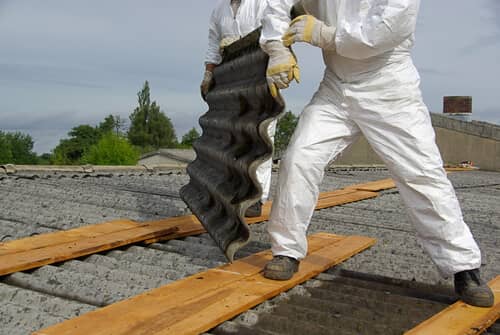
Asbestos Use In The United States
The term “asbestos” refers to a group of minerals that naturally occur in nature. Asbestos fibers contain atoms of silicone and oxygen in their molecular structure. These fibers can be separated into threads that are heat-, fire- and chemical-resistant and do not conduct electricity.
Those traits once made asbestos very popular in thousands of building and household products, including use as insulation. The widespread use created a problem: Asbestos fibers can cause mesothelioma, a cancer of the mesothelial (surrounding) linings of the lungs, abdomen or heart.
Millions of Americans are exposed to asbestos every day because of the fiber’s presence in many workplaces, buildings, homes and household products. Hundreds of thousands of people have died from asbestos exposure. Each year, about 3,000 people in the U.S. die from mesothelioma.
Asbestos Minerals Fall Into Two Groups
According to the National Cancer Institute (NCI), asbestos minerals are generally divided into two groups – amphibole and serpentine.
- Amphibole. Amphibole asbestos includes minerals such as actinolite, tremolite, anthophyllite, crocidolite and amosite. These minerals have straight, needle-like fibers that are brittle but are somewhat limited in their ability to be fabricated.
- Serpentine. Serpentine asbestos includes the mineral chrysotile, which has long, curly fibers that can be woven. It is chrysotile asbestos that is used in 95% of commercial applications in the United States and is most commonly linked to mesothelioma, asbestosis and other asbestos-related diseases.
Widespread Asbestos Use
Although asbestos has been mined in the United States and Canada since the late 1800s, its popularity increased during World War II as an insulator used in the shipbuilding industry to insulate boilers, steam pipes and hot water pipes.
Other industries quickly realized the supposed benefits of asbestos, and it became a staple in the automotive industry to make brake pads and clutch disks and in the construction industry as a home and building insulator. It was also used to strengthen cement and plastic; fabricate roofing, ceilings, flooring tiles and paints; and was commonly used in many household and garden products.
Even as the use of asbestos spread, manufacturers were already aware that the product caused fatal diseases, including asbestosis and mesothelioma.
Prolonged Asbestos Dormancy Period
Asbestos-related diseases such as mesothelioma and asbestosis can have a very long dormancy period. That is a time when the symptoms do not show up. In some cases, asbestos injury symptoms don’t materialize until 50 years after exposure. Equally troublesome is that many of those symptoms, such as coughing, shortness of breath and weight loss, are often misdiagnosed as these initial symptoms can relate to a variety of illnesses.
Sadly, many asbestos injury victims don’t discover that they have an asbestos-related cancer until the disease is in its latter stages.
Industries & Occupations At Risk For Mesothelioma
Asbestos was used in many industries and occupations over the past century because of its fire-retardant properties. However, most asbestos workers were not given masks, respirators or protective clothing to prevent asbestos inhalation. Those workers inhaled deadly asbestos fibers that led to mesothelioma, a cancer of the lining surrounding the lungs, heart and abdomen.
Mesothelioma injury lawsuits allege that asbestos manufacturers and suppliers knew that asbestos could cause mesothelioma, asbestosis and other lung cancers, but failed to warn the companies that used asbestos, the employees that worked with the fibers and others who were exposed to asbestos on a regular basis.
Industries At Risk For Mesothelioma
The most common industries which used asbestos were shipbuilding and repair and the automobile industry. However, anyone who worked with asbestos as an insulator, such as pipe fitters, construction workers, power plant workers and many others, may also have been exposed to asbestos fibers.
- Shipbuilding & Repair. Workers in the shipbuilding and repairing industry regularly used asbestos to insulate pipes, boiler rooms, walls, ceilings and floors – often in very tight spaces with little to no ventilation. Although shipyard asbestos use was thought to be at its highest during World War II, the Korean War and Vietnam, military and civilian shipyard workers continue to be one of the largest populations to suffer from mesothelioma.
- Automotive Industry. Asbestos is frequently found in brake linings, clutch facings, transmission components, disc brake pads, drum brake linings, brake blocks, gaskets and other parts due to its ability to resist heat. Brake and clutch maintenance is particularly hazardous as service requires them to be ground down in order to rejuvenate the brake linings. Regardless of the jobs performed, workers in the automotive industry were at a great risk of inhaling asbestos fibers as auto making and repair shops were generally not well ventilated.
- Insulator Jobs. Anyone who worked with asbestos as an insulator is also at a greater risk to develop mesothelioma. Pipe fitters working in power plants, steel mills, chemical plants, oil refineries and other industrial plants used asbestos to insulate pipes on a daily basis. Ironically, the few insulators who were required to wear protective gear were often provided with clothing made out of asbestos.
- Construction workers used asbestos to insulate homes and office buildings for decades and were further exposed to asbestos fibers that were used in tiles, flooring and ceiling components. In fact, anyone living or working in an older building may be exposed to asbestos. Sadly, asbestos was used as an insulator in the World Trade Towers. When the towers collapsed in 2001, tons of asbestos dust filled the New York City area, and many residents have developed asbestos-based injuries since that time.
Occupations At Risk For Mesothelioma
Workers in many occupations may also have been exposed to asbestos – some without ever knowing it. Here are just a few of the occupations where asbestos exposure may have occurred: aeronautical engineers, aircraft mechanics, auto mechanics, blacksmiths, boilermakers, brick and stone masons, building maintenance, bulldozer operators, cabinet makers, carpenters, crane operators, demolition and wrecking crews, draftsmen, drill press operators, drywall tapers, electric power linemen, electrical engineers, electricians, firefighters , foundry workers, freight and material handlers, furnace operators, heavy equipment mechanics, home inspectors, household appliance installers, HVAC workers, industrial engineers, iron workers, janitors, machinists, mechanics, masons, mechanical engineers, millwrights, miners, mixing operators, painters, plasterers, railroad workers, road machine operators, sheet metal workers, stationary engineers, steamfitters, structural metal craftsmen, telephone repairmen, textile operators, tile setters, tool makers and welders.
Did Your Job Cause Your Mesothelioma Claim?
If you have developed mesothelioma and want to know whether the disease is linked to a former job, turn to an Illinois law firm with a record of success and a team of skilled accident attorneys who know how to get results.
Salvi, Schostok & Pritchard P.C. offers a free, no-obligation evaluation of mesothelioma claims in Chicago and throughout Illinois. You will not pay for our legal services unless we obtain compensation for you and your family. Contact us toll free at 312-372-1227 or use our free online contact form.







